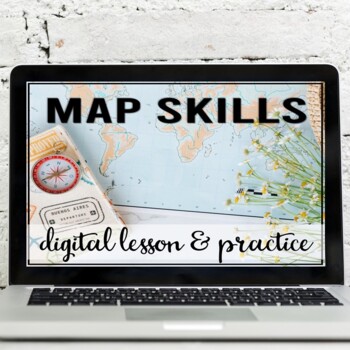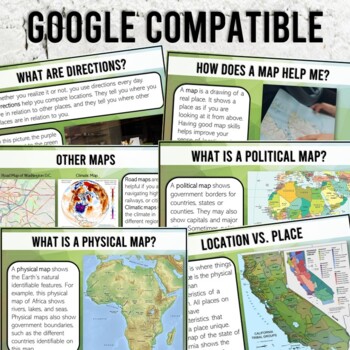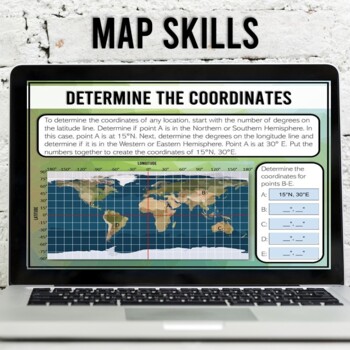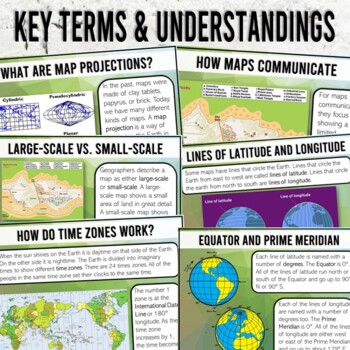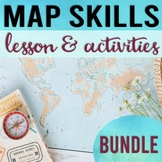Map Skills Digital Lesson and Practice Activities (Google Compatible)
- PDF
- Google Apps™
- Internet Activities

What educators are saying
Also included in
- If you are in need of a low prep map skills lesson and practice activities, this bundle includes both print and digital options to meet your various needs. Your students will gain an understanding of key terms and understandings and will have an opportunity to read, analyze, and apply their knowledgPrice $7.00Original Price $10.00Save $3.00
Description
If you are in need of a digital-friendly map skills lesson and practice activities, this resource is set up and ready to go! Your students will gain an understanding of key terms and understandings and will have an opportunity to read, analyze, and apply their knowledge of geographic features with various practice activities included throughout. This is set up in Google Slides with clickable links, drag & drop, and filling the blank activities. Answer keys are included!
This resource covers:
:: What are directions?
:: Directions in your space
:: How does a map help me?
:: Your knowledge of maps
:: What is a globe?
:: The continents
:: Label the continents (drag & drop)
:: What is satellite imagery (Google Earth link)
:: What are map projections?
:: What is a political map?
:: What is a physical map?
:: What is a topographic map?
:: Road maps, climatic maps, and economic and resource maps
:: Location vs. place
:: Determine your location and place (uses Google Earth)
:: Why maps are helpful
:: How maps communicate
:: Large scale vs. small scale (fill in the blank)
:: Parts of a map
:: Label the map (drag & drop)
:: Cardinal directions
:: Relative Location (read the map and fill in the blank)
:: Compass rose
:: Determine the photo direction (uses Google Earth)
:: Explore Machu Picchu (uses Google Earth)
:: What is a map scale?
:: How to find distance on Google Earth
:: How to find area and perimeter on Google Earth
:: Distance, area, and perimeter practice on Google Earth
:: What are map grids?
:: Use the map grid (determine and fill in the blank)
:: Lines of latitude and longitude
:: Equator and Prime Meridian
:: What are hemispheres?
:: Determine the hemisphere (drag & drop)
:: How to find coordinate directions
:: Determine the coordinate directions (fill in the blank)
:: How do time zones work?
:: Determine United States time zones (fill in the blank)
:: Maps then and now (analyze historical maps of United States)
:: Time-lapse (analyze the map about deforestation)
:: Make connections (uses Google Earth Timelapse)
:: What are resource maps?
:: Analyze the economic map (fill in the blank)
:: Read the road map (fill in the blank)
:: Reflection
This Resource Includes:
:: Informational text with key terms bolded
:: Lots of practice opportunities
:: Video links to go more in-depth
:: Answer keys & grading rubric
:: Everything is set up in Google Slides & ready to go!
CLICK THE GREEN PREVIEW BUTTON FOR MORE DETAILS
How it Works:
This lesson and activities can be conducted teacher-led or shared with students through Google Classroom as an independent assignment. Everything is set up for you. This resource is LOW PREP and would even make great sub plans. All work is completed digitally, so no printing is necessary. Your students will complete this in edit mode of Google Slides, however, this can be set up on various LMS.
Structure:
This lesson is structured. This means that the informational text and practice opportunities are set up to move through the concepts in an organized way so that your students are applying what they learn as they move through the slides.
Standards Alignment:
:: Common Core Standards for Reading Informational Text
:: Washington State Geography Standards Grades 6-8
:: Can be used as a cross-curricular activity as it fits many different standards
Answer Keys & Grading Rubric:
Answer keys for the map skills practice are included! A grading rubric is also included for short answer responses that assess: accuracy, thoroughness, validity, and writing conventions.
Technology:
Please note that students will need to access Google Earth™ to complete this assignment. Google Earth™ can be accessed on a desktop using Chrome as the browser. If using a tablet or smartphone, simply download the Google Earth App before starting the activity. Your students will also need access to YouTube to view the video clips. This activity also uses several other online maps. All links are set up within the activity and are editable.
If you have questions, feel free to reach out prior to purchasing. I can be reached directly by email at: michellemcdonald9515@gmail.com
Thank you!
Michelle McDonald, B.A.E.
Social Studies Education, K-12
Elementary Education K-8
* * * * * * * * * * * * * * * * * * * * * * * * * * * * * * * * * * * * * * * * * * * * * * * * * * * * * *
Connect with Me:
Instagram @mrsmcdonaldsclassroom
Facebook: mrsmcdonaldclassroom
Blog: StrategicEducationalServices.com
* * * * * * * * * * * * * * * * * * * * * * * * * * * * * * * * * * * * * * * * * * * * * * * * * * * * * *
Follow me on TpT to be the first to learn about new products, sales, and discounts. Follow Michelle McDonald

